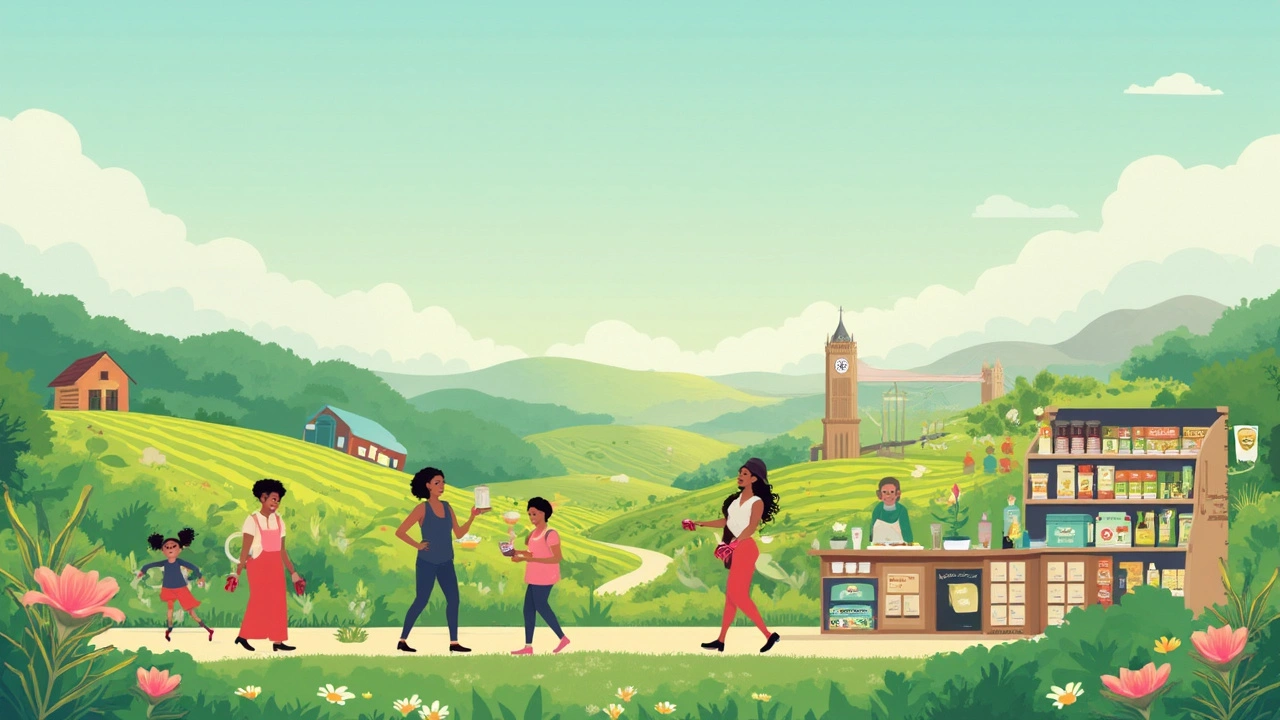Prebiotics are riding the wave of health trends, and for good reason—they’re great for your gut! But hey, before you add another scoop to your smoothie, let’s chat about their environmental footprint. We all want to do good by our planet, right?
Prebiotics aren’t just any fiber; they’re like the special agents that feed your gut's good bacteria. Now, that's cool, but how do they stack up when we consider sustainability? When we look at their production, packaging, and distribution, there’s a bigger picture at play.
One thing to consider is how these fibers are sourced. Many prebiotics come from things like chicory root or even seaweeds, and that's pretty neat because they usually have less water and pesticide needs compared to other crops. But it’s not all roses. The process to extract and process these fibers can sometimes be more resource-intensive than you’d think.
- What Are Prebiotics?
- Production Process and Sustainability
- Environmental Challenges
- Benefits Beyond Health
- Steps Towards More Eco-friendly Prebiotics
What Are Prebiotics?
Alright, let's break this down. So what exactly are prebiotics? They’re basically types of dietary fiber that our bodies can’t digest. I know, sounds a bit odd, right? But here's the cool part—these fibers become food for the good bacteria in your gut, helping them to grow and thrive.
You might have heard of probiotics, which are live bacteria found in some yogurts and fermented foods. Prebiotics, on the other hand, are more like the support team. They're found in foods like bananas, onions, garlic, and whole grains. They help nurture your gut microbiota, making sure those beneficial bacteria can stick around longer.
“Prebiotics nourish the beneficial microbes that are already in your gut, helping them to do their job even better,” says Dr. Mary Ellen Sanders, a leading researcher in the field of probiotics and prebiotics.
So Why Does This Matter?
Okay, aside from sounding like a gut health commercial, why should you care about prebiotics? Well, many studies suggest these fibers can enhance digestion, boost your immune system, and even play a role in lowering stress levels. Pretty neat, huh?
Quick Facts
- Prebiotics aren't destroyed by heat, making them great for cooking.
- Not all dietary fibers are prebiotics, so make sure you're choosing the right sources.
- The best way to get prebiotics is through a varied diet—eat a rainbow, as nutritionists like to say!
Production Process and Sustainability
When we talk about the production of prebiotics, it's all about how we get these dietary fibers from different natural sources. A big player in this game is chicory root, which is super popular because it readily provides inulin—a common prebiotic fiber.
Natural Sourcing
Chicory doesn't need hefty amounts of water or pesticides, which is great news for the environment. But not all sources follow this eco-friendly trend. Some prebiotics are derived from corn or sugar beets, and those can have a much bigger water and pesticide footprint, which isn't exactly what Mother Nature ordered.
Extraction and Processing
Once the raw materials are sourced, the production involves a series of steps like extraction, refining, and packaging. The sustainability hiccup here is the energy consumption during these processes. Extracting inulin, for example, can be energy-intensive because it involves heating and cooling.
Environmental Impact
It's not just the production phase, though. The entire lifecycle of prebiotics—from farm to table—can impact the environment. Consider packaging: plastic or non-renewable materials can add to pollution. Moreover, transporting these products globally churns out carbon emissions like there's no tomorrow.
Sustainable Innovations
Some companies are taking steps to curb this impact. They're turning to renewable energy sources, reducing waste, and using sustainable packaging materials. A few are even looking into local sourcing to cut down on transportation emissions.
| Prebiotic Source | Water Usage | Pesticide Needs |
|---|---|---|
| Chicory | Low | Low |
| Corn | High | High |
Being clued up about these factors can help us make greener choices. So next time you're picking up prebiotics, check the labels and look for brands committed to sustainability. It's a small effort that can go a long way in helping the planet while you keep your gut happy!

Environmental Challenges
So, what's the catch with the sustainability of prebiotics? While they're awesome for gut health, producing them isn't all sunshine and rainbows. Let's dig into some challenges their production poses to the planet.
Resource-Intensive Processes
Extracting fibers from sources like chicory root or certain grains requires a decent amount of energy and water. These processes might benefit our tummies but aren’t exactly eco-friendly when you consider the environmental toll. For example, converting inulin, a popular prebiotic, from chicory involves washing, slicing, diffusing, and purifying—it’s not simple.
Packaging Concerns
Next up, consider the packaging. Most prebiotics come in plastic containers or sachets. While great for shelf life, plastics contribute significantly to landfill waste and oceans' pollution if not properly managed. Moving to sustainable packaging could be a game-changer here.
Transportation Emissions
Transportation of these prebiotics from farms to processing plants and then to your local store involves fuel consumption, leading to CO2 emissions. It's a big issue since maintaining a low carbon footprint is key to sustainability.
Environmental Trade-offs
The rapid expansion in cultivation of crops like chicory can lead to land competition, affecting biodiversity and contributing to deforestation. It’s a delicate balance—feeding an eco-health spree without forcing the planet to pay a heavy price.
Benefits Beyond Health
We all know prebiotics are rock stars for gut health, but their impact doesn't just stop there. These dietary wonders are doing some pretty impressive stuff beyond our digestive system. So, what's on the list?
Reducing Environmental Footprint
That’s right. Incorporating more prebiotics in agriculture could be a game-changer for sustainability. Many of these plants, like the mighty chicory, can thrive with less water and fewer pesticides. Not only does this cut down on resources, but it also leads to healthier soils and reduced pollution. And healthier soils mean a better environment overall.
Supporting the Local Economy
Have you thought about how prebiotics can boost local economies? Since these fibers can be extracted from local plants, it opens up new opportunities for regional farmers and businesses. This means more jobs and stronger communities. By choosing products with sustainably sourced prebiotics, you’re supporting a cycle of local growth.
Lowering Greenhouse Gas Emissions
Here's another perk. By shifting towards more-efficient prebiotic production, there's potential to significantly lower greenhouse gas emissions. Less reliance on industrial fertilizers and chemical inputs leads to cleaner air and less harm to our ecosystems.
| Aspect | Impact |
|---|---|
| Water Use | Reduced by up to 30% |
| Pesticide Use | Minimal requirement |
| Local Economic Impact | Supports regional jobs |
Enhancing Biodiversity
Prebiotics often come from plants that contribute to biodiversity. This is a big deal since biodiversity is crucial for ecosystem balance. Varied crops in agriculture help maintain a resilient environment, which benefits us all in the long run.
So, besides being a friend to your gut, prebiotics can be pals with the planet, too. Your choice can make a difference—support sustainable prebiotic options, and you're helping steer us toward a greener future.

Steps Towards More Eco-friendly Prebiotics
We all have a part to play in making prebiotics more sustainable. From the ground up, there are several steps we can take. Let’s explore some practical ways we can reduce their environmental impact while still enjoying their health benefits.
Choose Sustainable Sources
Not all prebiotics are created equal. Opting for those derived from sustainable sources like chicory root or agave can make a difference. These plants generally require less water and no synthetic fertilizers. By supporting farmers who practice organic and regenerative agriculture, you're giving the planet a friendly high-five.
Cut Down on Packaging
Packaging is a big part of the problem. Look for brands committed to reducing waste. Recyclable or biodegradable packaging options are the way to go. Better yet, some companies are now offering refills or bulk options, which can save tons of materials in the long run.
Support Eco-friendly Brands
Brands committed to reducing their carbon footprint should be on your radar. Think about it—by choosing companies that use renewable energy in their manufacturing processes or offer carbon-neutral shipping, you're supporting not just your gut but also the planet.
Encourage Local Production
Choosing locally produced prebiotics means cutting down on the emissions from transporting goods halfway around the globe. When you buy local, not only do you get fresher products, but you're also supporting local economies and reducing your carbon footprint.
Spread the Word
Educating others about the environmental benefits of sustainable prebiotics can drive demand and encourage more companies to take the green path. Share what you know with friends, family, and even on social media. The more people know, the bigger the impact we can make.
Implementing these steps may seem small in the grand scheme of things, but they can collectively make a huge difference. Let's make sure our choice of prebiotics benefits both our health and the environment.


Honestly, a lot of the hype around prebiotics gets thrown around without any real scrutiny about their ecological footprint. Let's be clear—just because something is good for your gut doesn’t mean it's good for the planet. The production of prebiotic fibers like inulin often involves monocropping of chicory or other raw materials, which can cause soil degradation and biodiversity loss. Eco-friendliness isn’t just about the end product, but the entire lifecycle including packaging, transport, and waste. Plenty of articles gloss over these details, so I appreciate this post diving into sustainability.
However, we must demand more transparency from companies about their sourcing and manufacturing processes. Blindly trusting labels won’t cut it anymore. Consumers need to be equipped with factual data rather than marketing buzzwords. Is there any reliable data comparing prebiotics to other dietary fiber sources in terms of carbon footprint and land use? That would be very telling.
Bottom line: gut health is vital, but environmental costs must be factored in to make truly responsible choices.
Well, while I get that the environmental concerns are valid, I feel like we sometimes use sustainability as an excuse to demonize every health trend. Prebiotics have huge benefits, not only for individuals but also potentially for reducing the environmental footprint of food systems by promoting better gut microbiomes, which can influence digestion efficiency.
We definitely should push for better packaging solutions—biodegradable or minimal—but I think the bigger picture is to balance between health and sustainability rather than reject one outright. For example, if people switch from processed junk foods to fiber-rich prebiotics, that might reduce overall food waste too. It's a complex ecosystem.
Still, I'm curious if the article mentions how the environmental costs compare to other fiber sources like whole grains or legumes?
Oh, come on, let's not get all preachy about prebiotics like they're some new evil. Seriously, I love how everyone suddenly turned into eco-warriors overnight. Prebiotics are pretty much just fiber, folks. Like, have you seen how much plastic waste your grocery cart generates on a weekly basis? Focusing on packaging is great, but c’mon, let’s not lose perspective here.
That being said, I’m curious about the production side—does the article mention whether local sourcing is feasible or if most of these prebiotics come from far-away monocultures? Because I’ll bet that shipping footprint is way higher than the impact of growing these plants.
Overall though, I’m starving for some dirt on any actual scientific studies backing these sustainability claims.
I just started using prebiotic supplements a few months ago, and this article really opened my eyes to what I hadn’t considered before—the environmental side of things. It’s never just about our bodies; it’s about the bigger impact. Makes me want to look for brands that focus on eco-friendly packaging or sustainable farming practices.
Also, it reminds me how much we can influence companies by supporting those that prioritize the planet. If enough of us demand sustainability, maybe we’ll see a big shift in the industry.
Anybody else tried to find prebiotic sources that are both good for gut health and green? I’d love recommendations!
Look, all this talk about sustainability is just white noise if we don’t have real solutions. The truth is most supplements and health foods in the US come from massive industrial operations that prioritize profits over the planet. It’s frustrating to see so many people getting caught up in trends without addressing the underlying exploitation in agriculture.
I’m all for healthy guts, but not at the expense of rural communities overseas getting wrecked by giant factories pumping out these fibers. We can’t pretend to care unless we demand fair trade and environmental justice too.
The article sounds promising, but I hope it calls out the bigger players making this mess.
From an analytical standpoint, assessing the environmental impact of prebiotics necessitates a comprehensive life cycle assessment (LCA) from cultivation through consumption and disposal. Factors such as water usage, land degradation, carbon emissions from transport, and packaging materials ought to be quantified rigorously.
The article appears to highlight critical considerations; however, it will be imperative to compare these with equivalent values for alternative dietary sources to make an informed appraisal.
Moreover, the termination phase involving packaging disposal is often overlooked yet represents a significant source of ecological strain.
Such multidimensional evaluation is crucial to develop viable strategies that truly reconcile health with environmental stewardship.
This topic really piqued my curiosity because we often praise the health benefits without questioning what goes on behind the scenes. For instance, when prebiotics are extracted from chicory root or Jerusalem artichokes, is the farming done sustainably or with heavy pesticides and fertilizers? These chemicals not only harm soil health but also contribute to greenhouse gas emissions.
Packaging also gets me thinking—single-use plastics remain a big issue worldwide. Are manufacturers adopting any compostable or reusable alternatives that reduce landfill waste? The article hints at solutions but I'd like to see actual case studies or data points.
Environmental consciousness in health foods must go hand in hand to avoid unintended consequences.
I've noticed more and more brands promoting their 'green' prebiotic products, but the claims sometimes feel vague. Are their sustainability certifications legit? It'd be awesome if the community could compile a list of brands that truly practice environmentally friendly production methods.
On the positive side, educating consumers like this post does can definitely lead to smarter buying decisions. I personally try to support companies that use renewable energy and pack with biodegradable materials.
Anyone else think we could petition for clearer labeling standards here? Transparency is key.
Allow me to interject with some insights from the manufacturing perspective. A significant portion of prebiotics such as fructooligosaccharides (FOS) and inulin are derived from crops cultivated in monocultural practices, which admittedly raises sustainability flags with respect to soil depletion and pesticide reliance.
However, industry efforts are increasingly targeting regenerative agriculture, crop rotation, and organic farming to mitigate these concerns. Furthermore, advanced packaging technologies are being introduced by progressive companies that leverage compostable bioplastics and reduced packaging volumes, significantly cutting ecological footprints.
While it is critical to maintain scrutiny, I would advise consumers to engage in dialogue and support enterprises transitioning towards greener practices rather than dismiss prebiotics wholesale.
Thank you all for shedding light on different facets of this topic. I would like to add that the gut microbiome’s health ties indirectly into environmental health as well. For example, a well-balanced gut can improve digestion efficiency reducing methane production in humans and livestock if similar dietary principles were applied globally, potentially lowering greenhouse gases.
Moreover, as we face escalating climate challenges, choosing sustainable food sources including prebiotics cultivated responsibly is a tangible step individuals can undertake. The challenge remains in verifying the scientific validity of claims and practical availability.
Is there any research linking increased fiber consumption with measurable environmental benefits on a larger scale?
This conversation really emphasizes how intertwined our personal health choices are with planetary wellbeing. It's refreshing to see both optimism about benefits and skepticism about sustainability being voiced here—it keeps the discussion balanced and comprehensive.
I’m particularly interested in how grassroots efforts or consumer advocacy have influenced companies to prioritize eco-friendly methods for prebiotics. Does anyone know of any success stories or examples where customer demand led to meaningful changes in sourcing or packaging?
Also, maybe sharing resources for identifying truly sustainable brands would help others make informed purchasing decisions.
Let’s keep this dialogue going—there's so much to unpack but it's a crucial topic for all of us.